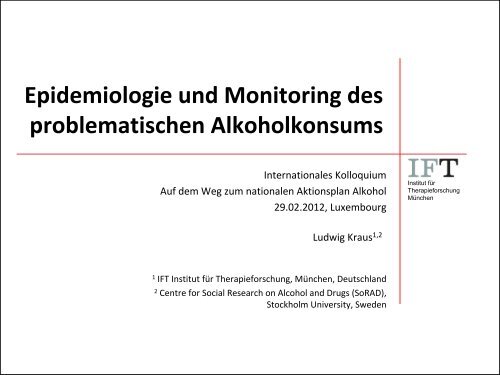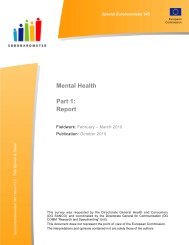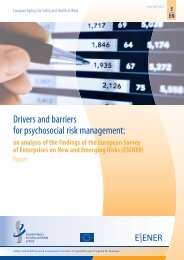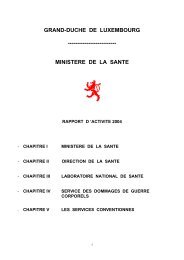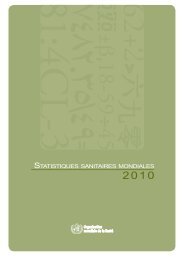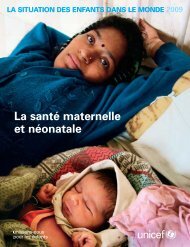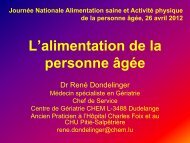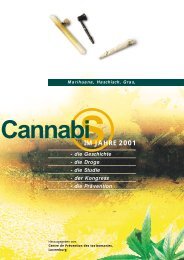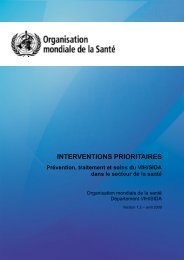3 Trinkmuster und Folgen Soziale Folgen
3 Trinkmuster und Folgen Soziale Folgen
3 Trinkmuster und Folgen Soziale Folgen
Erfolgreiche ePaper selbst erstellen
Machen Sie aus Ihren PDF Publikationen ein blätterbares Flipbook mit unserer einzigartigen Google optimierten e-Paper Software.
Epidemiologie <strong>und</strong> Monitoring des<br />
problematischen Alkoholkonsums<br />
1<br />
2<br />
Internationales Kolloquium<br />
Auf dem Weg zum nationalen Aktionsplan Alkohol<br />
29.02.2012, Luxembourg<br />
Ludwig Kraus 1,2<br />
IFT Institut für Therapieforschung, München, Deutschland<br />
Centre for Social Research on Alcohol and Drugs (SoRAD),<br />
Stockholm University, Sweden<br />
Institut für<br />
Therapieforschung<br />
München
Überblick<br />
1.<br />
2.<br />
3.<br />
4.<br />
5.<br />
6.<br />
Hintergr<strong>und</strong><br />
Durchschnittskonsum <strong>und</strong> <strong>Trinkmuster</strong><br />
<strong>Trinkmuster</strong> <strong>und</strong> ges<strong>und</strong>heitliche/soziale <strong>Folgen</strong><br />
Monitoring: Erwachsenen‐<br />
Beispiel: Risiko‐<br />
Ausblick<br />
Institut für<br />
Therapieforschung<br />
München<br />
<strong>und</strong> Jugendlichen Surveys<br />
<strong>und</strong> Maßnahmen‐Evaluation<br />
2
1Hintergr<strong>und</strong><br />
Epidemiologie <strong>und</strong> Monitoring (1)<br />
• Paradigmenwechsel in der Betrachtung von Alkoholkonsum <strong>und</strong><br />
<strong>Folgen</strong> (Rehm et al., 1996)<br />
―<br />
―<br />
Trinkmenge <strong>und</strong> <strong>Trinkmuster</strong><br />
Mediatoren zwischen Konsum <strong>und</strong> <strong>Folgen</strong><br />
• Durchschnittskonsum <strong>und</strong> <strong>Trinkmuster</strong><br />
―<br />
―<br />
―<br />
―<br />
Frequenz <strong>und</strong> Menge<br />
Exzessiver Konsum<br />
Trinkkontext (Mahlzeit)<br />
Trinksituation (Ort, Gesellschaft)<br />
Institut für<br />
Therapieforschung<br />
München<br />
3
1Hintergr<strong>und</strong><br />
Epidemiologie <strong>und</strong> Monitoring (2)<br />
Ein im Durchschnitt täglicher Konsum von einem Glas Wein<br />
―<br />
―<br />
Regelmäßiger Konsum von einem Glas Wein pro Tag<br />
Konsum von sieben Gläsern Wein an einem einzigen Tag.<br />
• Konsum mit <strong>und</strong> ohne Mahlzeit.<br />
• Konsum alleine <strong>und</strong> in Gesellschaft.<br />
• Unterschiedliche Risiken für akute <strong>und</strong> chronische <strong>Folgen</strong> in<br />
Abhängigkeit des Konsummusters, d. h. der Häufigkeit <strong>und</strong><br />
Menge der Trinkanlässe mit einem höheren Konsum als dem<br />
Durchschnittskonsum.<br />
Institut für<br />
Therapieforschung<br />
München<br />
4
1Hintergr<strong>und</strong><br />
Epidemiologie <strong>und</strong> Monitoring (3)<br />
Kausalmodel des Alkoholkonsums <strong>und</strong> der <strong>Folgen</strong> unter Berücksichtigung der<br />
Wirkmechanismen (Quelle: Babor et al., 2005, S.34)<br />
Institut für<br />
Therapieforschung<br />
München<br />
5
2<br />
Durchschnittskonsum <strong>und</strong> <strong>Trinkmuster</strong><br />
Zusammenhang mit negativen <strong>Folgen</strong> (1)<br />
Institut für<br />
Therapieforschung<br />
München<br />
Quelle: Midanik et al., Addicion, 1996 6
2<br />
Durchschnittskonsum <strong>und</strong> <strong>Trinkmuster</strong><br />
Zusammenhang mit negativen <strong>Folgen</strong> (2)<br />
Quelle: Midanik et al., Addiction, 1996<br />
Institut für<br />
Therapieforschung<br />
München<br />
7
2<br />
Durchschnittskonsum <strong>und</strong> <strong>Trinkmuster</strong><br />
Pro‐Kopf‐Konsum (Liter Ethanol)<br />
Quelle: WHO, Global Information System on Alcohol and Health (GISAH)<br />
Institut für<br />
Therapieforschung<br />
München<br />
8
2<br />
Durchschnittskonsum <strong>und</strong> <strong>Trinkmuster</strong><br />
Wöchentliches Rauschtrinken % (5+ Drinks)<br />
Quelle: WHO, Global Information System on Alcohol and Health (GISAH)<br />
Institut für<br />
Therapieforschung<br />
München<br />
9
2<br />
Durchschnittskonsum <strong>und</strong> <strong>Trinkmuster</strong><br />
Verbreitung nach Alkoholmenge<br />
Institut für<br />
Therapieforschung<br />
München<br />
2007 ESPAD 15‐16 Jahre: Durchschnittlicher Alkoholkonsum bei letzter Trinkgelegenheit in<br />
Zentiliter reinen Alkohols (Quelle: Hibell et al., 2009)<br />
10
2<br />
Durchschnittskonsum <strong>und</strong> <strong>Trinkmuster</strong><br />
Verbreitung nach <strong>Trinkmuster</strong> (1)<br />
Institut für<br />
Therapieforschung<br />
München<br />
2007 ESPAD 15‐16 Jahre: Trunkenheit bei letzter Konsumgelegenheit (Quelle: Hibell et al.,<br />
2009)<br />
11
2<br />
Durchschnittskonsum <strong>und</strong> <strong>Trinkmuster</strong><br />
Verbreitung nach <strong>Trinkmuster</strong> (2)<br />
Institut für<br />
Therapieforschung<br />
München<br />
2007 ESPAD 15‐16 Jahre: Konsum von 5 oder mehr alkoholischen Getränken bei einer<br />
Gelegenheit (ca. 60 Gram Reinalkohol) (Quelle: Hibell et al., 2009)<br />
12
2<br />
Durchschnittskonsum <strong>und</strong> <strong>Trinkmuster</strong><br />
Einfluss von Menge <strong>und</strong> Trinkverhalten (1)<br />
Risikokurven für soziale Probleme unter Berücksichtigung des Trinkverhaltens<br />
(Quelle: Kraus et al., Alcohol & Alcoholism, 2009)<br />
Institut für<br />
Therapieforschung<br />
München<br />
13
2<br />
Durchschnittskonsum <strong>und</strong> <strong>Trinkmuster</strong><br />
Einfluss von Menge <strong>und</strong> Trinkverhalten (2)<br />
Figure 2: Attributable fraction for social problems across consumption variables (men)<br />
alcohol attributable fraction fraction (AAF) (AAF)<br />
0,12<br />
0,1<br />
0,08<br />
0,06<br />
0,04<br />
0,02<br />
0<br />
≤ 1/2 gl.<br />
(7 gr)<br />
≤ 1 gl.<br />
(14 gr)<br />
AAF = 5%<br />
≤ 2 gl.<br />
(28 gr)<br />
≤ 3 gl.<br />
(42 gr)<br />
AAF AAF = = 19%<br />
19%<br />
Alkohol‐attributable Fraktionen für soziale Probleme unter Berücksichtigung des<br />
≤ 4 gl.<br />
(56 gr)<br />
Institut für<br />
Therapieforschung<br />
München<br />
Trinkverhaltens (Quelle: Kraus et al., Alcohol & Alcoholism, 2009) 14<br />
≤ 5 gl.<br />
(70 gr)<br />
average daily consumption<br />
no RSOD<br />
RSOD ≤ 1x per week<br />
RSOD ≥ 1x per week<br />
≤ 7 gl.<br />
(98 gr)<br />
AAF AAF = = 59%<br />
59%<br />
≤ 9 gl.<br />
(126 gr)<br />
> 9 gl.<br />
(>126 gr)
2<br />
Durchschnittskonsum <strong>und</strong> <strong>Trinkmuster</strong><br />
Einfluss von Menge <strong>und</strong> Trinkverhalten (3)<br />
Präventionsparadoxon<br />
• Das Risiko für soziale <strong>Folgen</strong> ist in der Gruppe der Konsumenten mit<br />
einem riskanten Durchschnittskonsum zwar am höchsten.<br />
• Da die Mehrheit der Personen mit Rauschkonsum aber einen im<br />
Durchschnitt moderaten Konsum aufweist, ist der Anteil, den diese<br />
Gruppe zur Gesamtbelastung beiträgt, höher als der Beitrag der Gruppe<br />
mit riskantem Durchschnittskonsum (Gmel et al., 2001; Kraus et al., 2009;<br />
Kreitmann, 1986; Skog, 1999, 2001; Stockwell et al., 1996).<br />
Institut für<br />
Therapieforschung<br />
München<br />
15
3<strong>Trinkmuster</strong> <strong>und</strong> <strong>Folgen</strong><br />
Ges<strong>und</strong>heitliche <strong>Folgen</strong> (1)<br />
Institut für<br />
Therapieforschung<br />
München<br />
• Krebs: M<strong>und</strong>‐, Rachen‐, Speiseröhrenkrebs, Neoplasmen des<br />
gastrointenstenalen, Traktes, Leberkrebs, Brustkrebs bei der Frau<br />
• Psychische Störungen oder Krankheiten des Nervensystems:<br />
Alkoholabhängigkeit, Alkoholmissbrauch, Depressionen, organische<br />
Hirnkrankheiten<br />
• Kardiovaskuläre Krankheiten: Koronare Herzkrankheit,<br />
zerebrovaskuläre Krankheiten<br />
• Gastrointestinale Krankheiten: Leberzirrhose, Gallensteine,<br />
Pankreatitis.<br />
• Maternale <strong>und</strong> perinatale Krankheiten: niedriges Geburtsgewicht,<br />
intrauterine Wachstumsstörungen, FAS.<br />
• Akute toxische Wirkung: Alkoholvergiftung.<br />
Quelle: Babor et al., 2005<br />
16
3 <strong>Trinkmuster</strong> <strong>und</strong> <strong>Folgen</strong><br />
Ges<strong>und</strong>heitliche <strong>Folgen</strong> (2)<br />
• Unfälle: Verkehrsunfälle, Stürze, Ertrinken <strong>und</strong> Verbrennungen,<br />
Unfälle am Arbeitsplatz<br />
• Selbst verursachte Verletzungen: Suizid<br />
• Gewaltsamer Tod: Mord, Totschlag<br />
Quelle: Babor et al., 2005<br />
Institut für<br />
Therapieforschung<br />
München<br />
17
3 <strong>Trinkmuster</strong> <strong>und</strong> <strong>Folgen</strong><br />
Ges<strong>und</strong>heitliche <strong>Folgen</strong> (3)<br />
• Metaanalysen fanden signifikant schädigende Effekte des<br />
Durchschnittskonsums auf Brustkrebs<br />
(Smith‐Warner et al., 1998;<br />
Corrao et al., 1999; Single et al., 1999; Gutjahr et al., 2001).<br />
• Metaanalysen fanden signifikante protektive Effekte moderaten<br />
Konsums auf KHK (Maclure, 1993; English et al., 1995; Single et al., 1999;<br />
Corrao et al., 2000). Hinweise auf die schädliche Wirkung starken<br />
Institut für<br />
Therapieforschung<br />
München<br />
Alkoholkonsums (Rehm et al., 1997; Corrao et al., 2000). Rauschtrinken<br />
(Bondy, 1996; Puddey et al., 1999).<br />
hat schädliche Auswirkungen auf KHK<br />
18
3 <strong>Trinkmuster</strong> <strong>und</strong> <strong>Folgen</strong><br />
Ges<strong>und</strong>heitliche <strong>Folgen</strong> (4)<br />
• Positiver Zusammenhang des Durchschnittskonsums mit dem<br />
Verkehrsunfallrisiko (Midanik et al., 1996). Über psychomotorische<br />
Leistung gibt es einen starken Einfluss des <strong>Trinkmuster</strong>s (Eckardt et<br />
al., 1998; Gruenewald et al., 1996; Rossow et al., 2001).<br />
• Die Zahl der tödlichen Unfälle steigt in vielen europäische Ländern<br />
mit steigendem Pro‐Kopf‐Konsum (Skog, 2001).<br />
• Linearen Zusammenhang zwischen Alkoholkonsum <strong>und</strong><br />
Suizidrisiko (z.B. Andréasson et al., 1988; Dawson, 1997). Kein protektiver<br />
Effekt des moderaten Konsums (Andréasson et al,. 1988; Dawson, 1997).<br />
Erhöhtes Suizidrisiko in Abhängigkeit der Häufigkeit des<br />
Rauschtrinkens (Rossow & Wichstrøm, 1994, Dawson, 1997).<br />
Institut für<br />
Therapieforschung<br />
München<br />
19
3 <strong>Trinkmuster</strong> <strong>und</strong> <strong>Folgen</strong><br />
<strong>Soziale</strong> <strong>Folgen</strong> (1)<br />
• Gewalt<br />
• Vandalismus<br />
• Öffentliche Ruhestörung<br />
• Familienprobleme: Scheidung/Eheprobleme; Kindesmissbrauch<br />
• Andere zwischenmenschliche Probleme<br />
• Finanzielle Probleme<br />
• Probleme am Arbeitsplatz ausgenommen von Arbeitsunfällen<br />
• Probleme im Erziehungs‐/Schulbereich<br />
• <strong>Soziale</strong> Kosten<br />
Quelle: Babor et al., 2005<br />
Institut für<br />
Therapieforschung<br />
München<br />
20
3 <strong>Trinkmuster</strong> <strong>und</strong> <strong>Folgen</strong><br />
<strong>Soziale</strong> <strong>Folgen</strong> (2)<br />
Institut für<br />
Therapieforschung<br />
München<br />
• Linear Zusammenhang zwischen Durchschnittskonsum <strong>und</strong> Gewalt<br />
hinreichend belegt (Dawson, 1997; Rossow, 2000; Wells et al., 2000). Keine<br />
protektive Wirkung moderaten Konsums (Dawson, 1997; Rossow, 2000;<br />
Wells et al., 2000). Keine reliablen Effekte im Bereich niedriger BAK‐<br />
Niveaus auf aggressives Verhalten (Graham et al., 1998). Erhöhtes<br />
Risiko für Gewalt in Abhängigkeit der Berauschungshäufigkeit<br />
(Dawson, 1997; Rossow et al., 1999, Wells et al., 2000).<br />
• Die selbstberichtete Häufigkeit von Gewalt (ohne Todesfolgen) ist<br />
in einigen Studien mit dem Pro‐Kopf‐Konsum korreliert (Skog & Bjørk,<br />
1988; Lenke, 1990; Norström, 1993, 1998), ebenso wie Häufigkeit von<br />
Mord/Totschlag.<br />
• Alkoholkonsum in einem öffentlichen Kontext (z.B. auf einer Party)<br />
ist mit einem erhöhten Risiko für aggressives Verhalten, Streit <strong>und</strong><br />
Autofahren unter dem Einfluss von Alkohol verb<strong>und</strong>en (Nyaronga et<br />
al., 2009; Rossow et al., 1996; Wells et al., 2005; 2008).<br />
21
3 <strong>Trinkmuster</strong> <strong>und</strong> <strong>Folgen</strong><br />
<strong>Soziale</strong> <strong>Folgen</strong> (3)<br />
Institut für<br />
Therapieforschung<br />
München<br />
• Erhöhtes Risiko für Indikatoren des Kindsmissbrauchs bei Familien<br />
mit starkem Alkoholkonsum der Erziehungsberechtigten (Rossow,<br />
2000). Starker Alkoholkonsum hat einen Einfluss auf<br />
Kindesmisshandlung.<br />
• Positiver Zusammenhang mit sozialen <strong>Folgen</strong> (bedingt durch<br />
Alkohol: Streit in der Familie, Sorgen von Familienmitgliedern,<br />
Verlust von Partner/Fre<strong>und</strong>, physische Auseinandersetzungen)<br />
moderiert über Konsummuster exzessiven Trinkens (Kraus et al., 2009).<br />
• Zusammenhang zwischen Durchschnittskonsum <strong>und</strong> Problemen am<br />
Arbeitsplatz (Absentismus , niedrige Produktivität, inadäquates<br />
Verhalten, Diebstahl <strong>und</strong> andere kriminelle Delikte, schlechtes<br />
Arbeitsklima <strong>und</strong> niedrige Arbeitsmoral). Berauschung <strong>und</strong><br />
Rauschtrinken sind mit Problemen am Arbeitsplatz auch dann<br />
signifikant verb<strong>und</strong>en, wenn für den Durchschnittskonsum<br />
kontrolliert wurde (Rehm & Rossow, 2001).<br />
22
3 <strong>Trinkmuster</strong> <strong>und</strong> <strong>Folgen</strong><br />
<strong>Soziale</strong> <strong>Folgen</strong> (4)<br />
Institut für<br />
Therapieforschung<br />
München<br />
• Vorglühen vor einer Party <strong>und</strong> Trinkspiele erhöhen das Risiko für<br />
Blackouts (LaBrie et al., 2011).<br />
• Exzessives Trinken führt zu mehr negativen Konsequenzen (z.B.<br />
unbedachte oder riskante Verhaltensweisen), wenn es allein im<br />
Vergleich zu „in Gesellschaft“ praktiziert wird (Christiansen et al., 2002).<br />
23
4<br />
Monitoring<br />
Erwachsenen‐<br />
Konsummengen<br />
• Abstinenz, ≤ 20/30 g Ethanol pro Tag für moderaten Konsum <strong>und</strong><br />
>20/30 g Ethanol pro Tag für starken Konsum (British Medical<br />
Assoziation, 1995).<br />
• Abstinenz, ≤ 12/24 Ethanol pro Tag für risikoarmen Konsum <strong>und</strong><br />
>12/24 g Ethanol pro Tag für riskanten Konsum (Seitz, Bühringer &<br />
Mann, 2008).<br />
<strong>und</strong> Jugendlichen Surveys (1)<br />
Institut für<br />
Therapieforschung<br />
München<br />
• Abstinenz, ≤ 19.99/39.99 g Ethanol für Kategorie I; ≤ 20–39.99/40–<br />
59.99 g Ethanol pro Tag für Kategorie II; ≤ 40/60 g Ethanol pro Tag<br />
Kategorie III (Rehm et al., 2004).<br />
24
4<br />
Monitoring<br />
Erwachsenen‐<br />
Konsummuster<br />
•Rauschtrinken<br />
—<br />
in der Regel operationalisiert als der Konsum von fünf oder mehr<br />
alkoholischen Getränken bei einer Trinkgelegenheit (Gmel, Rehm &<br />
Kuntsche, 2003). Alternativ wird die Häufigkeit von Rauschzuständen<br />
(Intoxikation) direkt erhoben.<br />
•Konsumkontext<br />
―<br />
Konsum zu<br />
Mahlzeiten, auf einer Party/Feier, zu Hause, bei Fre<strong>und</strong>en<br />
zu Hause, am Arbeitsplatz, in einer Bar/Kneipe/Disco, in einem<br />
Restaurant.<br />
•Konsumsituationen<br />
―<br />
<strong>und</strong> Jugendlichen Surveys (2)<br />
Konsum mit einem Partner, mit Familienangehörigen, mit<br />
Arbeitskollegen, mit Fre<strong>und</strong>en, alleine.<br />
Institut für<br />
Therapieforschung<br />
München<br />
25
Country Risk drinking measure definition: number of standard<br />
drinks (ethanol in grams)<br />
standard drinks /glasses Grams (approximately)<br />
Switzerland 8+ 80 for men and women<br />
Germany 5+ 70 for men and women<br />
Israel 5+ 60<br />
Mexico 5+ 65<br />
Sweden 6+ 72<br />
Finland 6+ / 5+ from GF measure 60<br />
Netherlands 6+ 60<br />
Czech Republic 5+glasses 90<br />
Hungary<br />
Sum of frequencies drinking 3-5 and 6+<br />
drinks<br />
60<br />
Brazil 5+ 60<br />
Iceland 5+ 65<br />
Denmark 6+ 72<br />
Sri Lanka 5+ 60<br />
Nigeria 5+ 60<br />
Kazakhstan 5+ 60<br />
Argentina 5+ 60<br />
Canada 5+ 68<br />
USA 5+ 60 – 70<br />
Uganda 5+ 60<br />
Japan Sum of frequencies for 6-9 and 10+ units 72<br />
Costa Rica 5+ 60<br />
India 5+ 50<br />
Australia 6+ 60<br />
Ireland 6+ 60<br />
Uruguay 5+ 60<br />
Belize 5+ 50<br />
Peru 5+ 60<br />
Australia 6+ 60<br />
New Zealand 6+ 60<br />
Quelle: Bloomfield, Hope & Kraus, in press<br />
Institut für<br />
Therapieforschung<br />
München<br />
Overview of risk<br />
drinking definitions<br />
from the GENACIS<br />
project (volume per<br />
drinking occasion)<br />
(Gender, Alcohol and<br />
Culture: An International<br />
Study, 2009)<br />
26
Country Men Women Standard<br />
drink/unit<br />
g/day g/week g/day g/week g<br />
Europe<br />
Austria 24 16 10-20<br />
Bulgaria 16-48 224 8-32 112 8-10<br />
Czech Republic 20 20 na<br />
Denmark 60/po 252<br />
(21 units)<br />
60/po 168<br />
(14 units) 12<br />
Estonia 20 10 10<br />
Finland 84/po 288 60/p.o. 192 12<br />
France 30 20 10<br />
Germany 24 12 14<br />
Ireland<br />
210<br />
(21 SD)<br />
140<br />
(14 SD)<br />
Italy 40 20 12<br />
Latvia 220 120 10<br />
Malta 168-210 112-140 8-10<br />
Netherlands 20-30 10-20 10<br />
Poland 40 20 10<br />
Slovakia 20 20 na<br />
Slovenia 20 140 10 70 10<br />
Spain<br />
40/day<br />
280 20-25/day<br />
170 10<br />
60/po<br />
40/po<br />
Sweden 168 108 12<br />
Switzerland 20 20 10-13<br />
UK 24-32 16-24 8<br />
Australasia<br />
Australia 20 20 10<br />
Japan 1-2 units 19.75<br />
New Zealand 30 210 20 140 10<br />
North America<br />
Canada 27.2 190 27.2 121.5 13.6<br />
US (DHHS) 14.28 196 14 98 14<br />
US(NIAAA) 56 196 42 98 14<br />
US(AHA) 28 14 14<br />
Africa<br />
South Africa 252 168<br />
10<br />
Institut für<br />
Therapieforschung<br />
München<br />
Overview of<br />
drinking limits in<br />
European countries<br />
and in countries<br />
outside of Europe.<br />
(Anderson & Gordon,<br />
2009; International<br />
Center for Alcohol<br />
Policies [ICAP], 2009)<br />
Quelle: Bloomfield,<br />
Hope & Kraus, in<br />
press<br />
27
4<br />
Konsummenge <strong>und</strong> Konsummuster<br />
Der Mangel an klar ersichtlichen Schwellenwerten für riskanten<br />
Konsum veranlasste Room <strong>und</strong> Kollegen zu folgender<br />
Schlussfolgerung:<br />
•„The lack of a threshold in the relationships between alcohol<br />
consumption and the harms measured [...] means that there is no one<br />
ideal guideline for avoiding ‘risky’ drinking“ (Room, Bondy & Ferris, 1995, S.<br />
511).<br />
Monitoring<br />
Erwachsenen‐<br />
<strong>und</strong> Jugendlichen Surveys (3)<br />
Institut für<br />
Therapieforschung<br />
München<br />
28
4<br />
Monitoring<br />
Beispiel: Risiko Evaluation (1)<br />
Gibt es einen spezifischen Effekt von Alkopops auf das<br />
Trinkverhalten Jungedlicher <strong>und</strong> damit verb<strong>und</strong>ene negative<br />
<strong>Folgen</strong>?<br />
Alkopops wurden mit einer Reihe von Auswirkungen in Verbindung<br />
gebracht (Roberts et al., 1999, Romanus, 2000; Hughes et al., 1997;<br />
Lanier et al., 2005).<br />
• Designer‐Getränke verführen Jugendliche zum vorzeitigen<br />
Alkholkonsum.<br />
• Alkopopkonsumenten<br />
—fangen früher mit dem Konsum an,<br />
—trinken häufiger <strong>und</strong> größere Mengen <strong>und</strong><br />
—berichten häufiger über Intoxikationen.<br />
Institut für<br />
Therapieforschung<br />
München<br />
29
4<br />
Monitoring<br />
Beispiel: Risiko Evaluation (2)<br />
Institut für<br />
Therapieforschung<br />
München<br />
Untersuchung des Einflusses des Alkopopkonsums auf das<br />
Trinverhalten von Jugendlichen <strong>und</strong> damit verb<strong>und</strong>ene negative <strong>Folgen</strong><br />
―<br />
―<br />
unter Berücksichtigung der Trinkmenge <strong>und</strong><br />
des Anteils von Alkopops an der Gesamttrinkmenge<br />
•Analyse auf der Gr<strong>und</strong>lage von deutschen Surveydaten der<br />
Europäischen Schülerstudie zu Alkohol <strong>und</strong> anderen Drogen (ESPAD).<br />
•Ein alkopop‐spezifischer Effekt auf problematische <strong>Trinkmuster</strong> <strong>und</strong><br />
negative Konsequenzen konnte nicht nachgewiesen werden.<br />
•Entscheidende Einflußfaktoren sind Trinkmenge <strong>und</strong> Häufigkeit des<br />
Rauschtrinkens.<br />
•Konsumenten, die nur Alkopops getrunken hatten, zeigten weniger<br />
häufig riskante Konsummuster <strong>und</strong> wiesen weniger negative <strong>Folgen</strong> auf<br />
im Vergleich zu den anderen Konsumentengruppen (Kraus, Metzner &<br />
Piontek, 2010).<br />
30
4<br />
Monitoring<br />
Beispiel: Maßnahmen Evaluation (1)<br />
War die Deutsche Alkopopsteuer wirksam?<br />
• Einführung der Alkopopsteuer in Deutschland im Jahr 2004.<br />
• Rückgang des Konsums spirituosenhaltiger Alkopops in den<br />
Folgejahren.<br />
• Zunahme des Konsums nicht spirituosenhaliger Alkopops (auf Bier‐<br />
<strong>und</strong> Weinbasis).<br />
• Untersuchung des Effekts der Steuererhöhung auf das<br />
Trinkverhalten Jugendlicher.<br />
• Hypothesen:<br />
―<br />
―<br />
Substitution durch nicht besteuerte alkoholische Getränke.<br />
Kein Effekt auf den Gesamtalkoholkonsum.<br />
Institut für<br />
Therapieforschung<br />
München<br />
31
4<br />
Monitoring<br />
Beispiel: Maßnahmen Evaluation (2)<br />
War die Deutsche Alkopopsteuer wirksam?<br />
Institut für<br />
Therapieforschung<br />
München<br />
• Daten zum Trinkverhalten Jugendlicher vor <strong>und</strong> nach der Einführung<br />
der Alkopopsteuer.<br />
• Surveydaten der Europäischen Schülerstudie zu Alkohol <strong>und</strong> anderen<br />
Drogen (ESPAD) von 2003 <strong>und</strong> 2007.<br />
�<br />
�<br />
�<br />
�<br />
�<br />
Der Konsum von Alkopops nahm ab, der Konsum von Bier <strong>und</strong> Spirituosen<br />
nahm zu.<br />
Keine Änderung des Gesamtalkoholkonsums.<br />
Deutliche Hinweise auf eine Substitution von Alkopops durch andere<br />
alkoholische Getränke.<br />
Verschiebung hin zu Spirituosen mit riskanteren <strong>Trinkmuster</strong>n verb<strong>und</strong>en.<br />
Einführung von bier‐ <strong>und</strong> weinbasierten Alkopops, die für unter 18‐Jährige<br />
verfügbar sind (Müller, Piontek, Pabst, Baumeister & Kraus, 2010).<br />
32
5 Monitoring problematischen Konsums<br />
Ausblick<br />
Populationssurveys (Erwachsene <strong>und</strong> Jugendliche)<br />
•Erfassung von Konsummengen <strong>und</strong> Kontextvariablen<br />
•Risikoanalysen, Trinker‐<br />
<strong>und</strong> Populationsbezogen<br />
•Evaluierung alkoholpolitischer Maßnahmen<br />
•Trends über wiederholte Querschnittssurveys<br />
�<br />
�<br />
Zeitliche Entwicklung<br />
Analyse von Alters‐, Perioden‐<br />
<strong>und</strong> Kohorteneffekten<br />
•Basisdaten zur Schätzungen alkoholbezogener Morbidität <strong>und</strong><br />
Mortalität (Global Burden of Disease (GBD))<br />
�<br />
Modellierung der Verteilungen von Konsummengen in der<br />
allgemeinen Bevölkerung unter Berücksichtigung aggregierter<br />
Verkaufsstatistiken<br />
Institut für<br />
Therapieforschung<br />
München<br />
33
Kontakt: kraus@ift.de<br />
Vielen Dank für Ihre Aufmerksamkeit!<br />
Institut für<br />
Therapieforschung<br />
München<br />
34
6 Literatur<br />
Institut für<br />
Therapieforschung<br />
München<br />
Anderson P. & Gordon, R. (2009) Recommendations about sensible drinking amounts. Results of a survey. Retrieved November 10th 2010 from: http://ec<br />
europa eu/health/ph_determinants/life_style/alcohol/documents/ev_20090217_co02_en pdf 2009.<br />
Andréasson S., Allebeck P. & Romelsjö A. (1988) Alcohol and mortality among young men: longitudinal study of Swedish conscripts. British Medical Journal<br />
296, 1021‐1025.<br />
Babor T., Caetano R., Casswell S., Edwards G., Giesbrecht N., Graham K., Grube J., Gruenewald P., Hill L., Holder H., Homel R., Österberg E., Rehm J., Room R.<br />
& Rossow I. (2005) Alkohol ‐ Kein gewöhnliches Konsumgut (Herausgeber der deutschen Ausgabe mit Beiträgen zur Alkoholpolitik in Deutschland,<br />
Österreich <strong>und</strong> der Schweiz: L Kraus, J Rehm, G Gmel, A Uhl & F Fröhner). Göttingen: Hogrefe. (Original erschienen 2003: Alcohol: no ordinary<br />
commodity).<br />
Bloomfield K., Hope A. & Kraus L. (2011) Alcohol survey measures for Europe: A literature review. Drugs: Education, Prevention and Policy, Early online, 1‐<br />
13.<br />
Bondy S.J. (1996) Drinking patterns and their consequences: report from an international meeting –Overview of studies on drinking patterns and<br />
consequences. Addiction 91, 1663‐1674.<br />
British Medical Association (BMA) (1995) Alcohol: guidelines on sensible drinking. London: British Medical Association.<br />
Christiansen M., Vik P. W.& Jarchow A. (2002) College student heavy drinking in social contexts versus alone. Addictive Behaviors 27, 393–404.<br />
Corrao G., Bagnardi V., Zambon A. & Arico S. (1999) Exploring the dose‐response relationship between alcohol consumption and the risk of several alcohol‐<br />
related conditions: a meta‐analysis. Addiction 94, 1551‐1573.<br />
Corrao G., Rubbiati L., Bagnardi V., Zambon A. & Poikolainen K. (2000) Alcohol and coronary heart disease: a meta‐analysis. Addiction 95, 1505‐1523.<br />
Dawson D.A. (1997) Alcohol, drugs, fighting and suicide attempt/ideation. Addiction Research 5, 51‐472.<br />
Eckardt M.J., File S.E., Gessa G.L., Grant K.A., Guerri C., Hoffman P.L., Kalant H., Koob G.F., Li T.‐K. & Tabakoff B. (1998) Effects of moderate alcohol<br />
consumption on the central nervous system. Alcoholism: Clinical and Experimental Research 22, 998‐1040.<br />
Gender Alcohol and Culture: An International Study (2009) Recommendations for the use of drinking indicators. Retrieved from http://www genacis<br />
org/index php10<br />
Gmel G., Klingemann S., Müller R. & Brenner D. (2001) Revising the preventive paradox: the Swiss case. Addiction 96 (2), 273‐284.<br />
Gmel G., Rehm J. & Kuntsche E. (2003) Binge drinking in Europe: definitions, epidemiology, and consequences. Sucht 49 (2), 105‐116.<br />
Graham K., Leonard K.E., Room R., Wild T.C., Pihl R.O., Bois C. & Single E. (1998) Current directions in research in <strong>und</strong>erstanding and preventing intoxicated<br />
aggression. Addiction 93, 659‐676.<br />
Gruenewald P.J., Mitchell P.R. & Treno A.J. (1996) Drinking and driving: drinking patterns and drinking problems. Addiction 91, 1637‐1649.<br />
Gutjahr E. & Gmel G. (2001) The social costs of alcohol consumption. In: Klingemann H. & Gmel G. (eds.) Mapping the social consequences of alcohol<br />
consumption, pp. 133‐143. Dordrecht: Kluwer Academic Publishers.<br />
Hibell B., Guttormsson U., Ahlström S., Balakireva O., Bjarnason T., Kokkevi A. & Kraus L. (2009) The 2007 ESPAD report. Substance use among students in<br />
35 European countries. Stockholm: The Swedish Council for Information on Alcohol and other Drugs (CAN).<br />
35
6 Literatur<br />
Institut für<br />
Therapieforschung<br />
München<br />
Hughes K., MacKintosh A. M., Hastings G. et al. (1997) Young people, alcohol, and designer drinks: a quantitative and qualitative study. British Medical<br />
Journal 314, 414–418.<br />
International Center for Alcohol Policies (2010) International drinking guidelines. http://www icap org/table/InternationalDrinkingGuidelines. Retrieved<br />
November 10th 2010 from: http://www.icap.org/table/InternationalDrinkingGuidelines.<br />
Kraus L., Baumeister S.E., Pabst A. & Orth B. (2009) Association of average daily alcohol consumption, binge drinking and alcohol‐related social problems:<br />
Results from the German Epidemiological Surveys of Substance Abuse. Alcohol and Alcoholism 44 (3), 314‐320.<br />
Kraus L., Metzner C. & Piontek D. (2010) Alcopops, alcohol consumption and alcohol‐related problems in a sample of German adolescents: Is there an<br />
alcopop‐specific effect? Drug and Alcohol Dependence 110 (1‐2), 15‐20.<br />
Kreitman N. (1986) Alcohol consumption and the preventive paradox. British Journal of Addiction 81 (3), 353‐363.<br />
LaBrie J. W., Hummer J., Kenney S., Lac A. & Pedersen E. (2011) Identifying Factors That Increase the Likelihood for Alcohol‐Induced Blackouts in the<br />
Prepartying Context. Substance Use & Misuse 46, 992–1002.<br />
Lanier S. A., Hayes J. E. & Duffy V. B. (2005) Sweet and bitter tastes of alcoholic beverages mediate alcohol intake in of‐age <strong>und</strong>ergraduates. Physiology &<br />
Behavior 83, 821–831.<br />
Lenke L. (1990) Alcohol and criminal violence: time series analysis in a comparative perspective. Stockholm: Almquist & Wiksell International.<br />
Maclure M. (1993) Demonstration of deductive meta‐analysis: ethanol intake and risk of myocardial infarction. Epidemiologic Reviews 15, 328‐351.<br />
Midanik L. T., Tam T. W. Greenfield T. K. & Caetano R. (1996). Risk functions for alcohol‐related problems in a 1988 US national sample. Addiction 91 (10),<br />
1427‐1437.<br />
Müller S., Piontek D., Pabst A., Baumeister S. E. & Kraus L. (2010) Changes in alcohol consumption and beverage preference among adolescents after the<br />
introduction of the alcopops tax in Germany. Addiction 105 (7), 1205‐1213.<br />
Norström T. (1993) Family violence and total consumption of alcohol. Nordisk Alkoholtidskrift 10, 311‐318.<br />
Norström T. (1998) Effects on criminal violence of different beverage types and private and public drinking. Addiction 93, 689‐699.<br />
Nyaronga D., Greenfield Z. & McDaniel P. (2009) Drinking Context and Drinking Problems Among Black, White, and Hispanic Men and Women in the 1984,<br />
1995, and 2005 U.S. National Alcohol Surveys (2009). Journal of Studies on Alcohol and Drugs 70, 16‐26.<br />
Puddey I.B., Rakic V., Dimmitt S.B. & Beilin L.J. (1999) Influence of pattern of drinking on cardiovascular disease and cardiovascular risk factors: a review.<br />
Addiction 94, 649‐663.<br />
Rehm J. & Fischer B. (1997) Measuring harm: implications for alcohol epidemiology. In: Plant M., Single E. & Stockwell T. (eds.) Alcohol: minimising the<br />
harm: what works?, pp. 248‐261. London: Free Association Books Ltd.<br />
Rehm J. & Rossow I. (2001) The impact of alcohol consumption on work and education. In: Klingemann H. & Gmel G. (eds.) Mapping the social<br />
consequences of alcohol consumption, pp. 67‐77. Dordrecht: Kluwer Academic Publishers.<br />
Rehm J., Ashley M. J., Room R., Single E., Bondy S., Ferrence R. & Giesbrecht N. (1996) On the emerging paradigm of drinking patterns and their social and<br />
health consequences. Addiction 91 (11), 1615‐1621.<br />
36
6 Literatur<br />
Institut für<br />
Therapieforschung<br />
München<br />
Rehm J., Room R., Monteiro M., Gmel G., Graham K., Rehn N., Sempos C., Frick U. & Jernigan D. (2004) Alcohol use. In M. Ezzati, A. Lopez, A. Rodgers & C. J.<br />
L. Murray (Eds.), Comparative quantification of health risks: global and regional burden of disease due to selected major risk factors (pp. 959‐1108).<br />
Geneva: WHO.<br />
Roberts C., Blakey V. & Tudor‐Smith, C. (1999) The impact of “alcopops” on regular drinking by young people in Wales. Drugs‐Education Prevention and<br />
Policy 6, 7–15.<br />
Romanus G. (2000) Alcopops in Sweden—a supply side initiative. Addiction 95 (Suppl. 4), S609–S619.<br />
Room R., Bondy S. J. & Ferris J. (1995) The risk of harm to oneself from drinking, Canada 1998. Addiction 90, 449‐513.<br />
Rossow I. & Wichstrom L. (1994) Parasuicide and use of intoxicants among Norwegian adolescents. Suicide and Life‐Threatening Behavior 24, 174‐183.<br />
Rossow I. (1996) Alcohol‐related violence: the impact of drinking pattern and drinking context. Addiction 91, 1651‐1661.<br />
Rossow I. (2000) Suicide, violence and child abuse: review of the impact of alcohol consumption on social problems. Contemporary Drug Problems 27, 397‐<br />
434.<br />
Rossow I. (2001) Drinking and violence: a cross‐cultural comparison of the relationship between alcohol consumption and homicide in 14 European<br />
countries. Addiction 96 (Suppl. 1), 77‐92S.<br />
Rossow I., Pape H. & Wichstrøm L. (1999) Young, wet and wild? Associations between alcohol intoxication and violent behaviour in adolescence. Addiction<br />
94, 1017‐1031.<br />
Seitz H. K., Bühringer G. & Mann K. (2008) Grenzwerte für den Konsum alkoholischer Getränke [Limit values for the consumption of alcoholic drinks]. In<br />
Deutsche Hauptstelle für Suchtfragen (Eds.), Jahrbuch Sucht 2008 (pp. 205‐208). Geesthacht: Neuland.<br />
Single E., Robson L., Rehm J. & Xie X. (1999) Morbidity and mortality attributable to alcohol, tobacco, and illicit drug use in Canada. American Journal of<br />
Public Health 89, 385‐390.<br />
Skog O. J. (1999). The prevention paradox revisited. Addiction 94 (5), 751‐757.<br />
Skog O. J. (2001) Alcohol consumption and mortality rates from traffic accidents, accidental falls, and other accidents in 14 European countries. Addiction 96<br />
(Suppl. 1), 49‐58.<br />
Skog O.‐J. & Bjørk E. (1988) Alkohol og voldskriminalitet. En analyse av utviklingen i Norge 1931‐1982 (Alcohol and violent crimes. An analysis of the 1931‐<br />
1982 trends in Norway). Oslo: SIFO.<br />
Skog O.‐J. (2001) Alcohol consumption and mortality rates from traffic accidents, accidental falls, and other accidents in 14 European countries. Addiction<br />
96 (Suppl. 1), 49‐58S.<br />
Smith‐Warner S.A., Spiegelman D., Yaun S.‐S., Van den Brandt P.A., Folsom A.R., Goldbohm R.A., Graham S., Holmberg L., Howe G.R., Marshall J.R., Miller<br />
A.B., Potter J.D., Speizer F.E., Willett W.C., Wolk A. & Hunter D.J. (1998) Alcohol and breast cancer in women: a pooled analysis of cohort studies.<br />
Journal of the American Medical Association 279, 535‐540.<br />
Stockwell T., Hawks D., Lang E. & Rydon P. (1996) Unravelling the preventive paradox for acute alcohol problems. Drug and Alcohol Review 15, 7‐15.<br />
Wells S., Graham K. & West P. (2000) Alcohol‐related aggression in the general population. Journal of Studies on Alcohol 61, 626‐632.<br />
37
6 Literatur<br />
Institut für<br />
Therapieforschung<br />
München<br />
Wells S., Graham K., Speechley M. & John J. Koval J. J. (2005) Drinking patterns, drinking contexts and alcohol‐related aggression among late adolescent and<br />
young adult drinkers. (2005). Addiction 100, 933‐944.<br />
Wells S., Mihic L., Tremblay P. F., Graham K. & Demers A. (2008) Where, With Whom, and How Much Alcohol Consumed on Drinking Events Involving<br />
Aggression? Event‐Level Associations in a Canadian National of University Students. Alcoholism: Clinical and Experimental Research 32, 522–533.<br />
WHO, Global Information System on Alcohol and Health (GISAH).<br />
38


